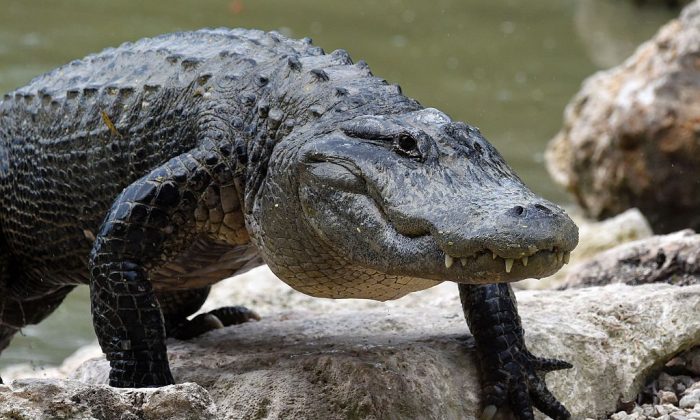TAMPA, Florida—Staff at a U.S. Air Force base in Florida had to bring in a front-end loader to remove an alligator that was lounging on a runway.
The Tampa Bay Times reports that the large reptile was spotted Tuesday morning on a MacDill Air Force Base flight line.
The base shared a photo of the creature on Facebook, saying the friendly alligator was just “preparing for take-off.”
MacDill spokesman 2nd Lt. Brandon Hanner says alligator sightings are common around the base, which is located on Tampa Bay. He says the alligator probably surfaced from one the base’s bodies of water.
The wing safety office’s wildlife manager organized the animal’s removal, scooping it into the bucket of the loader.
750-Pound Alligator in Florida
Officers at the Jupiter Police Department removed a 750-pound alligator from a local park in Jupiter, Florida, on March 28.
Responding to an alligator call the officers removed the 12 feet long reptile from the Commerce Park area. The department shared their adventure in a Facebook post.
“He was carefully removed without harm from the area and relocated to a safe place,” police said in the post.
Alligators versus Crocodiles
The American alligator is much smaller than the Nile crocodile, usually topping out at 15 feet. While that may already sound massive, the biggest Nile crocodiles can be longer than a giraffe is tall, according to National Geographic.
While average size Nile crocs weigh around 500 pounds, like the American alligator captured in Florida, large ones can weigh up to 1,650 pounds.
Head Shape
Another difference is the shape of the head.
Alligators have broader, U-shaped rounder heads, while crocodiles have more triangular, V-shaped, longer and narrower skulls.
However, as with most things in life, there are exceptions to the rules.
Mugger crocodiles, Crocodilis palustris, have a broad snout like an alligator.

Habitat
Habitat is another big difference.
All crocodiles have special glands in their tongues that can get rid of excess salt, so they tend to be found in saltwater habitats, such as mangrove swamps and estuaries. Alligators, on the other hand, do not have these glands, so they prefer to live in freshwater habitats.
However, saltwater crocodiles are at home in both freshwater and saltwater habitats, and often swim along coastlines.
Teeth
Teeth are also a point of difference.
For crocodiles, the fourth tooth on the lower jaw sticks up over the upper lip, making it visible when the mouth is closed. On alligators, this fourth tooth is covered up.
Offspring
Nile crocodiles also have fewer offspring than American alligators, according to Abby Lawson, a doctoral candidate in the Department of Forestry and Environmental Conservation at Clemson University.
Aggressiveness
Additionally, “Nile crocodiles are generally considered to be much more aggressive than American alligators or American crocodiles,” said Adam Rosenblatt, an expert on crocodiles and a postdoctoral associate at the Yale School of Forestry and Environmental Sciences.
With its man-eater reputation, the Nile crocodile can reach 20 feet in length and take down everything from hippos to humans, the National Geographic reported.
Nile crocodiles aren’t picky eaters, although their primary diet consists of fish. Their indiscriminate diet means they’ll happily take a chomp out of whatever or whoever crosses their path, from zebras, porcupines, humans, and even other crocodiles. At every feeding time, a Nile crocodile can eat up to half its weight.
While American alligators and crocodiles account for 33 human fatalities since 2000, the Nile crocodile has killed 268 people in the same time span, according to National Geographic.
Because of its vicious reputation, the Nile crocodile was hunted close to extinction in the 1940s through the 1960s, according to the National Geographic. Since then, local and international protections have helped them rebound in most areas.
However, in some regions, pollution, hunting, and habitat loss have severely depleted their numbers.
Actually, the Nile crocodile is not the largest crocodilian.
The largest is a saltwater crocodile known as Crocodylus porosus which can reach 23 feet and weigh up to 2,600 pounds.
That makes for some monstrous crocodiles.
Epoch Times reporter Tiffany Meier and Venus Upadhayaya contributed to this article.


